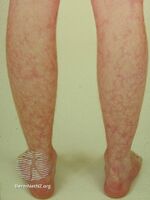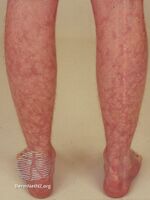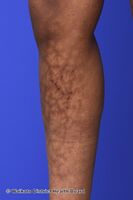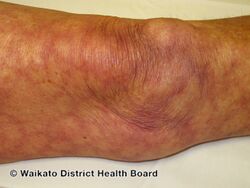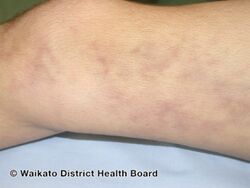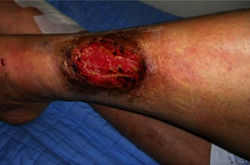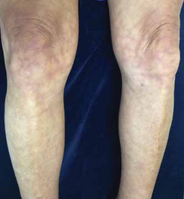Livedo reticularis
| Livedo reticularis | |
|---|---|
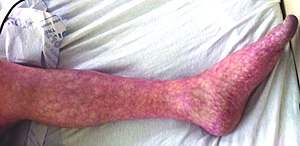 | |
| Livedo reticularis secondary to obscure severe infrarenal aortoiliac stenosis with transient lactic acidosis. | |
| Symptoms | Purpura, mottling of the skin, blood clots, skin discoloration |
| Causes | Autoimmune diseases, hyperlipidemia, poisons, drug abuse |
Livedo reticularis is a skin finding consisting of a mottled reticulated vascular pattern that appears as a lace-like purplish discoloration of the skin.[1][2] The discoloration is caused by reduction in blood flow through the arterioles that supply the cutaneous capillaries, resulting in deoxygenated blood showing as blue discoloration. This can be a secondary effect of a condition that increases a person's risk of forming blood clots, including a wide array of pathological and nonpathological conditions. Examples include hyperlipidemia, microvascular hematological or anemia states, nutritional deficiencies, hyper- and autoimmune diseases, and drugs/toxins.
The condition may be normal or related to more severe underlying pathology.[3] Its differential diagnosis is broadly divided into possible blood diseases, autoimmune (rheumatologic) diseases, cardiovascular diseases, cancers, and endocrine disorders. It can usually (in 80% of cases) be diagnosed by biopsy.[4]
It may be aggravated by exposure to cold, and occurs most often in the lower extremities.[5]
The condition's name derives from the Latin livere which means bluish, and reticular which refers to the net-like pattern.[6]
Signs and symptoms
Causes
A number of conditions may cause the appearance of livedo reticularis:
- Cutis marmorata telangiectatica congenita, a rare congenital condition
- Sneddon syndrome – association of livedoid vasculitis and systemic vascular disorders, such as strokes, due to underlying genetic cause[7]
- Idiopathic livedo reticularis – the most common form of livedo reticularis, completely benign condition of unknown cause affecting mostly young women during the winter:[8] It is a lacy purple appearance of skin in extremities due to sluggish venous blood flow. It may be mild, but ulceration may occur later in the summer.[9]
- Secondary livedo reticularis:
- Vasculitis autoimmune conditions:
- Livedoid vasculitis – with painful ulceration occurring in the lower legs
- Polyarteritis nodosa
- Systemic lupus erythematosus[10]
- Dermatomyositis
- Rheumatoid arthritis
- Lymphoma
- Pancreatitis[11]
- Chronic pancreatitis[12]
- Tuberculosis
- Drug-related:
- Adderall (side effect)[citation needed]
- Amantadine (side effect)
- Bromocriptine (side effect)
- Beta interferon treatment, e.g. in multiple sclerosis[13][14][15]
- Livedo reticularis associated with rasagiline[16]
- Methylphenidate and dextroamphetamine-induced peripheral vasculopathy[17]
- Gefitinib[18]
- Obstruction of capillaries:
- Cryoglobulinaemia – proteins in the blood that clump together in cold conditions[19]
- Antiphospholipid syndrome due to small blood clots
- Hypercalcaemia (raised blood calcium levels which may be deposited in the capillaries)
- Haematological disorders of polycythaemia rubra vera or thrombocytosis (excessive red cells or platelets)
- Infections (infective endocarditis, syphilis, tuberculosis, Lyme disease)
- Associated with acute kidney injury due to cholesterol emboli status after cardiac catheterization
- Arteriosclerosis (cholesterol emboli)[20][21] and homocystinuria (due to Chromosome 21 autosomal recessive Cystathionine beta synthase deficiency)
- Intra-arterial injection (especially in drug addicts)
- Ehlers-Danlos syndrome – connective tissue disorder, often with many secondary conditions, may be present in all types
- Pheochromocytoma[22]
- Livedoid vasculopathy and its association with factor V Leiden mutation[23]
- FILS syndrome (polymerase ε1 mutation in a human syndrome with facial dysmorphism, immunodeficiency, livedo, and short stature)[24]
- Primary hyperoxaluria, oxalosis (oxalate vasculopathy)[25][26][27][28][29]
- Cytomegalovirus infection (very rare clinical form, presenting with persistent fever and livedo reticularis on the extremities and cutaneous necrotizing vasculitis of the toes)[30]
- Generalized livedo reticularis induced by silicone implants for soft tissue augmentation[31]
- As a rare skin finding in children with Down syndrome[32][33]
- Idiopathic livedo reticularis with polyclonal IgM hypergammopathy[34]
- CO2 angiography (rare, reported case)[35]
- A less common skin lesion of Churg–Strauss syndrome[36]
- Erythema nodosum-like cutaneous lesions of sarcoidosis showing livedoid changes in a patient with sarcoidosis and Sjögren's syndrome[37]
- Livedo vasculopathy associated with IgM antiphosphatidylserine-prothrombin complex antibody[38]
- Livedo vasculopathy associated with plasminogen activator inhibitor-1 promoter homozygosity and prothrombin G20210A heterozygosity[38]
- As a first sign of metastatic breast carcinoma (very rare)[39]
- Livedo reticularis associated with renal cell carcinoma (rare)[40]
- Buerger's disease (as an initial symptom)[41]
- As a rare manifestation of Graves hyperthyroidism[42]
- Associated with pernicious anaemia[43]
- Moyamoya disease (a rare, chronic cerebrovascular occlusive disease of unknown cause, characterized by progressive stenosis of the arteries of the circle of Willis leading to an abnormal capillary network and resultant ischemic strokes or cerebral hemorrhages)[44]
- Associated with the use of a midline catheter[45]
- Familial primary cryofibrinogenemia.[46]
- Vasculitis autoimmune conditions:
Diagnosis
Livedo reticularis is diagnosed by its clinical appearance and history. No further test or examination confirms idiopathic livedo reticularis, however, further investigations may be undertaken where an underlying cause is suspected such as skin biopsies, or blood tests for antibodies associated with antiphospholipid syndrome or systemic lupus erythematosus.[47]
Treatment
Other than identifying and treating any underlying conditions in secondary livedo,[48] idiopathic livedo reticularis may improve with warming the area.
See also
- Livedoid dermatitis
- Livedo racemosa
- Perinatal gangrene of the buttock
- erythema ab igne (AKA livedo recticularis e calore) - a rash caused by prolonged heat exposure (e.g. hot water bottle or heat pad)
- List of cutaneous conditions
References
- ↑ Rapini, Ronald P.; Bolognia, Jean L.; Jorizzo, Joseph L. (2007). Dermatology: 2-Volume Set. St. Louis: Mosby. p. 1615. ISBN 978-1-4160-2999-1.
- ↑ Wakelin, Sarah H. (2020). "22. Dermatology". In Feather, Adam; Randall, David; Waterhouse, Mona (eds.). Kumar and Clark's Clinical Medicine (10th ed.). Elsevier. p. 682. ISBN 978-0-7020-7870-5. Archived from the original on 2021-12-11. Retrieved 2021-12-11.
- ↑ "livedo reticularis" at Dorland's Medical Dictionary
- ↑ Kroshinsky; Stone, John H.; Bloch, Donald B.; Sepehr, Alireza (February 2009). "Case 5-2009 — A 47-Year-Old Woman with a Rash and Numbness and Pain in the Legs". New England Journal of Medicine. 360 (7): 711–20. doi:10.1056/NEJMcpc0807822. PMID 19213685.
- ↑ James, William D.; Elston, Dirk; Treat, James R.; Rosenbach, Misha A.; Neuhaus, Isaac (2020). "35.Cutaneous vascular diseases". Andrews' Diseases of the Skin: Clinical Dermatology (13th ed.). Edinburgh: Elsevier. p. 817. ISBN 978-0-323-54753-6. Archived from the original on 2023-03-18. Retrieved 2023-03-18.
- ↑ Sundriyal, Deepak; Kumar, Naveen; Kumar, Gaurav; Walia, Meenu (15 May 2014). "Livedo reticularis heralding hypercalcaemia of malignancy". BMJ Case Reports. 2014: bcr2013201371. doi:10.1136/bcr-2013-201371. PMC 4024535. PMID 24832704.
- ↑ Sneddon IB (April 1965). "Cerebro-Vascular Lesions And Livedo Reticularis". British Journal of Dermatology. 77 (4): 180–5. doi:10.1111/j.1365-2133.1965.tb14628.x. PMID 14278790. S2CID 43219068.
- ↑ Gibbs, Mark B.; English, Joseph C.; Zirwas, Matthew J. (2005). "Livedo reticularis: an update". J Am Acad Dermatol. 52 (6): 1009–19. doi:10.1016/j.jaad.2004.11.051. PMID 15928620.
- ↑ Feldaker M, Hines E, Kierland R (1955). "Livedo reticularis with summer ulcerations". AMA Arch Dermatol. 72 (1): 31–42. doi:10.1001/archderm.1955.03730310033007. PMID 14387292.
- ↑ Golden R (March 1963). "Livedo reticularis in systemic lupus erythematosus". Arch Dermatol. 87 (3): 299–301. doi:10.1001/archderm.1963.01590150015002. PMID 13948706.
- ↑ Sigmund W, Shelley W (1954). "Cutaneous manifestations of acute pancreatitis, with special reference to livedo reticularis". N Engl J Med. 251 (21): 851–3. doi:10.1056/NEJM195411182512104. PMID 13214346.
- ↑ Gould, Jennifer W.; Helms, Stephen E.; Schulz, Susan M.; Stevens, Seth R. (1998). "Relapsing livedo reticularis in the setting of chronic pancreatitis". Journal of the American Academy of Dermatology. 39 (6): 1035–1036. doi:10.1016/S0190-9622(98)70290-7. PMID 9843029.
- ↑ Rot, Uroš; Ledinek, Alenka Horvat (December 2013). "Interferons beta have vasoconstrictive and procoagulant effects: a woman who developed livedo reticularis and Raynaud phenomenon in association with interferon beta treatment for multiple sclerosis". Clinical Neurology and Neurosurgery. 115 (Suppl 1): S79–81. doi:10.1016/j.clineuro.2013.09.027. PMID 24321162. S2CID 11757438.
- ↑ Fox, Michelle; Tahan, Steven; Kim, Caroline C. (2012). "Livedo Reticularis: A Side Effect of Interferon Therapy in a Pediatric Patient with Melanoma". Pediatric Dermatology. 29 (3): 333–5. doi:10.1111/j.1525-1470.2011.01426.x. PMID 21575046. S2CID 37285113.
- ↑ Cruz, Boris Afonso; de Queiroz, Eustáquio; Nunes, Simone Vilela; Cruz Filho, Achiles; Campos, Gilberto Belisario; de Carvalho Monteiro, Ernesto Lentz; Crivellari, Humberto (2000). "Fênomeno de Raynaud grave associado a terapia com interferon-beta para esclerose múltipla: relato de caso" [Severe Raynaud's phenomenon associated with interferon-beta therapy for multiple sclerosis: case report]. Arquivos de Neuro-Psiquiatria (in português). 58 (2B): 556–9. doi:10.1590/S0004-282X2000000300025. PMID 10920422.
- ↑ Strowd, Lindsay C.; Lee, Andrew D.; Yosipovitch, Gil (June 2012). "Livedo Reticularis Associated With Rasagiline (Azilect)". Journal of Drugs in Dermatology. 11 (6): 764–5. PMID 22648227. Archived from the original on 2021-03-05. Retrieved 2021-11-28.
- ↑ Syed, Reema H.; Moore, Terry L. (2008). "Methylphenidate and Dextroamphetamine-Induced Peripheral Vasculopathy". Journal of Clinical Rheumatology. 14 (1): 30–33. doi:10.1097/RHU.0b013e3181639aaa. PMID 18431096.
- ↑ Blume, Jonathan E.; Miller, Craig C. (2007). "Livedo reticularis with retiform purpura associated with gefitinib (Iressa®)". International Journal of Dermatology. 46 (12): 1307–8. doi:10.1111/j.1365-4632.2007.03319.x. PMID 18173531. S2CID 43388374.
- ↑ Langhof H, Braun G, Matzkowski H (1957). "Livedo reticularis durch Kältegelierung des Blutes bei γ-Plasmocytom" [Livedo reticularis due to cold gelation of the blood by gamma-plasmacytoma]. Archiv für Klinische und Experimentelle Dermatologie (in Deutsch). 205 (4): 343–50. doi:10.1007/BF00693523. PMID 13522017. S2CID 10434333.
- ↑ Kazmier F, Sheps S, Bernatz P, Sayre G (1966). "Livedo reticularis and digital infarcts: a syndrome due to cholesterol emboli arising from atheromatous abdominal aortic aneurysms". Vasc Dis. 3 (1): 12–24. PMID 5903590.
- ↑ Stewart W, Lauret P, Testart J, Thomine E, Boulliê M, Leroy D (1977). "Les manifestations cutanées des emoblies de critaux de cholestérol" [Cutaneous cholesterol emboli]. Ann Dermatol Venereol (in français). 104 (1): 5–8. PMID 843026.
- ↑ Buckley, Sarah A.; Lessing, Juan N.; Mark, Nicholas M. (2013). "Livedo Reticularis in a Patient with Pheochromocytoma Resolving After Adrenalectomy". The Journal of Clinical Endocrinology & Metabolism. 98 (2): 439–40. doi:10.1210/jc.2012-2842. PMID 23275529.
- ↑ Yong AA, Tan AW, Giam YC, Tang MB (December 2012). "Livedoid vasculopathy and its association with factor V Leiden mutation" (PDF). Singapore Med J. 53 (12): e258–60. PMID 23268168. Archived (PDF) from the original on 2016-03-04. Retrieved 2021-11-28.
- ↑ Pachlopnik Schmid, Jana; Lemoine; Nehme, Nadine; Cormier-Daire, Valéry; Revy, Patrick; Debeurme, Franck; Debré, Marianne; Nitschke, Patrick; Bole-Feysot, Christine; Legeai-Mallet, Laurence; Lim, Annick; de Villartay, Jean-Pierre; Picard, Capucine; Durandy, Anne; Fischer, Alain; de Saint Basile, Geneviève (2012). "Polymerase ε1 mutation in a human syndrome with facial dysmorphism, immunodeficiency, livedo, and short stature ('FILS syndrome')" (PDF). Journal of Experimental Medicine. 209 (13): 2323–30. doi:10.1084/jem.20121303. PMC 3526359. PMID 23230001.
{{cite journal}}: CS1 maint: url-status (link) - ↑ Jorquera-Barquero, E.; Súarez-Marrero, M.C.; Fernández Girón, F.; Borrero Martín, J.J. (2013). "Oxalosis y livedo reticularis" [Oxalosis and Livedo Reticularis]. Actas Dermo-Sifiliográficas (in español). 104 (9): 815–8. doi:10.1016/j.ad.2012.04.019. PMID 23103120.
- ↑ Bogle MA, Teller CF, Tschen JA, Smith CA, Wang A (October 2003). "Primary hyperoxaluria in a 27-year-old woman". J. Am. Acad. Dermatol. 49 (4): 725–8. doi:10.1067/s0190-9622(03)00119-1. PMID 14512927.
- ↑ Marconi V, Mofid MZ, McCall C, Eckman I, Nousari HC (February 2002). "Primary hyperoxaluria: report of a patient with livedo reticularis and digital infarcts". J. Am. Acad. Dermatol. 46 (2 Suppl Case Reports): S16–8. doi:10.1067/mjd.2002.105475. PMID 11807460.
- ↑ Shih HA, Kao DM, Elenitsas R, Leyden JJ (October 2000). "Livedo reticularis, ulcers, and peripheral gangrene: cutaneous manifestations of primary hyperoxaluria". Arch Dermatol. 136 (10): 1272–4. doi:10.1001/archderm.136.10.1272-a. PMID 11030785.
- ↑ Singh S, Tai C, Ganz G, et al. (April 1999). "Steroid-responsive pleuropericarditis and livedo reticularis in an unusual case of adult-onset primary hyperoxaluria". Am. J. Kidney Dis. 33 (4): e5.1–e5.6. doi:10.1016/s0272-6386(99)70246-5. PMID 10196036.
- ↑ Arslan, Ferhat; Batirel, Ayse; Mert, Ali; Ozer, Serdar (2012). "Cytomegalovirus (CMV)-related cutaneous necrotizing vasculitis: Case report and literature review". The Brazilian Journal of Infectious Diseases. 16 (5): 482–5. doi:10.1016/j.bjid.2012.08.002. PMID 22975173.
- ↑ Camacho, Diana; Machan, Shalma; Pilesanski, Ursula; Revelles, Juan Maria; Martín, Lucia; Requena, Luis (2012). "Generalized Livedo Reticularis Induced by Silicone Implants for Soft Tissue Augmentation". The American Journal of Dermatopathology. 34 (2): 203–7. doi:10.1097/DAD.0b013e31821cb3c5. PMID 22441370.
- ↑ Bilgili SG, Akdeniz N, Karadag AS, Akbayram S, Calka O, Ozkol HU (2011). "Mucocutaneous disorders in children with down syndrome: case-controlled study". Genet. Couns. 22 (4): 385–92. PMID 22303799.
- ↑ Daneshpazhooh M, Nazemi TM, Bigdeloo L, Yoosefi M (2007). "Mucocutaneous findings in 100 children with Down syndrome". Pediatr Dermatol. 24 (3): 317–20. doi:10.1111/j.1525-1470.2007.00412.x. PMID 17542890. S2CID 25151006.
- ↑ ENDO, Yuichiro; MIYACHI, Yoshiki; YOSHIKAWA, Yoshiaki (2011). "John Libbey Eurotext : Éditions médicales et scientifiques France : revues, médicales, scientifiques, médecine, santé, livres". European Journal of Dermatology. Jle.com. 21 (2): 266–7. doi:10.1684/ejd.2010.1226. PMID 21489905.
- ↑ Johnson, Philip L.; Neperud, Julie; Arnold, Jill; Thomas, James (2011). "Livedo Reticularis and Bowel Ischemia after Carbon Dioxide Arteriography in a Patient with CREST Syndrome". Journal of Vascular and Interventional Radiology. 22 (3): 395–9. doi:10.1016/j.jvir.2010.11.012. PMID 21277800.
- ↑ Bosco, Laura; Peroni, Anna; Schena, Donatella; Colato, Chiara; Girolomoni, Giampiero (2010). "Cutaneous manifestations of Churg–Strauss syndrome: Report of two cases and review of the literature". Clinical Rheumatology. 30 (4): 573–80. doi:10.1007/s10067-010-1593-1. PMID 20949297. S2CID 24158646.
- ↑ Yamamoto, Toshiyuki; Takenoshita, Hideo (September 2010). "John Libbey Eurotext : Éditions médicales et scientifiques France : revues, médicales, scientifiques, médecine, santé, livres". European Journal of Dermatology. Jle.com. 20 (5): 640–641. doi:10.1684/ejd.2010.1034 (inactive 31 October 2021). PMID 20610374. Archived from the original on 2014-02-16. Retrieved 2014-03-19.
{{cite journal}}: CS1 maint: DOI inactive as of October 2021 (link) - ↑ 38.0 38.1 Tabata, N; Oonami, K; Ishibashi, M; Yamazaki, M (2010). "Livedo Vasculopathy Associated with IgM Anti-phosphatidylserine-prothrombin Complex Antibody". Acta Dermato Venereologica. 90 (3): 313–4. doi:10.2340/00015555-0835. PMID 20526560.
- ↑ Gambichler, T.; Baier, P.; Altmeyer, P. (2009). "Generalized livedo reticularis as the first sign of metastatic breast carcinoma". Clinical and Experimental Dermatology. 34 (2): 253–4. doi:10.1111/j.1365-2230.2008.02801.x. PMID 19120398. S2CID 1965405.
- ↑ Erel, Arzu; Ozsoy, Esra; University, Gazi (2001). "Livedo reticularis associated with renal cell carcinoma". International Journal of Dermatology. 40 (4): 299–300. doi:10.1046/j.1365-4362.2001.00895.x. PMID 11454094. S2CID 46560722.
- ↑ Takanashi, Tetsuo; Horigome, Reiko; Okuda, Yasuaki; Nose, Masato; Matsuda, Masayuki; Ikeda, Shu-Ichi (2007). "Buerger's Disease Manifesting Nodular Erythema with Livedo Reticularis". Internal Medicine. 46 (21): 1815–9. doi:10.2169/internalmedicine.46.0143. PMID 17978541.
- ↑ Liel Y (June 2004). "Livedo reticularis: a rare manifestation of Graves hyperthyroidism associated with anticardiolipin antibodies". South. Med. J. 97 (6): 601–3. doi:10.1097/00007611-200406000-00019. PMID 15255431.
- ↑ Bandyopadhyay, D. (2003). "Celecoxib-induced fixed drug eruption". Clinical and Experimental Dermatology. 28 (4): 452. doi:10.1046/j.1365-2230.2003.01285_5.x. PMID 12823316. S2CID 33331314.
- ↑ Richards, Kristen A.; Paller, Amy S. (2003). "Livedo Reticularis in a Child with Moyamoya Disease". Pediatric Dermatology. 20 (2): 124–7. doi:10.1046/j.1525-1470.2003.20205.x. PMID 12657007. S2CID 20135035.
- ↑ Shrestha NK, Gordon SM, Isada CM (2002). "Livedo reticularis associated with the use of a midline catheter". Scand. J. Infect. Dis. 34 (11): 845–6. doi:10.1080/0036554021000026942. PMID 12578157. S2CID 42667906.
- ↑ van Geest AJ, van Dooren-Greebe RJ, Andriessen MP, Blomjous CE, Go IH (January 1999). "Familial primary cryofibrinogenemia". J Eur Acad Dermatol Venereol. 12 (1): 47–50. doi:10.1111/j.1468-3083.1999.tb00808.x. PMID 10188150. S2CID 23748363.
- ↑ Ngan, Vanessa (September 2016). Oakley, Amanda (ed.). "Livedo reticularis". DermNet NZ. Archived from the original on February 4, 2018. Retrieved February 2, 2018.
- ↑ Fleischer A, Resnick S (1990). "Livedo reticularis". Dermatol Clin. 8 (2): 347–54. doi:10.1016/S0733-8635(18)30506-0. PMID 2191805.
External links
| Classification | |
|---|---|
| External resources |
- DermNet Archived 2016-08-01 at the Wayback Machine
- Pages with script errors
- CS1 português-language sources (pt)
- CS1 Deutsch-language sources (de)
- CS1 français-language sources (fr)
- CS1 maint: url-status
- CS1 español-language sources (es)
- CS1 maint: DOI inactive as of October 2021
- All articles with unsourced statements
- Articles with unsourced statements from February 2019
- Articles with invalid date parameter in template
- Webarchive template wayback links
- Vascular-related cutaneous conditions
- Rheumatology
